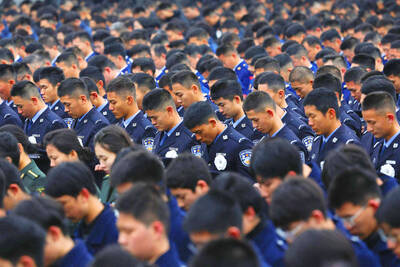Africa and much of South Asia face extreme risk from climate change but top carbon polluters will be relatively shielded from its ravages, according to a ranking of 166 countries obtained by AFP on Wednesday.
Somalia, Haiti and Afghanistan top the Climate Change Vulnerability Index, calculated from dozens of variables measuring the capacity of a country to cope with the consequences of global warming.
“We wanted to look at what is going to impact human populations,” said Fiona Place, environmental risk analyst at Maplecroft, a Britain-based firm that provides global risk intelligence for businesses.
Even if the world agrees at make-or-break climate talks in December to slash carbon dioxide emissions, many of those impacts — rising sea levels, increased disease, flooding and drought — are already inevitable, UN scientists say.
Of the 28 nations deemed at “extreme risk”, 22 are in Africa.
Bangladesh and Sri Lanka are similarly threatened, with Pakistan right on the edge and India not far behind.
At the other end of the spectrum, Norway, Finland, Japan, Canada and New Zealand are best insulated, because of a combination of wealth, good governance, well-managed ecosystems and high resource security.
The US and Australia — the largest per capita emitters of carbon dioxide among developed nations — are comfortably within the top 15 countries least at risk, the index showed.
With the exception of Chile and Israel, the rest of the 41 countries in the “low risk” category of the ranking are European or from the Arab Peninsula.
Japan’s enviable position is a result of its highly-developed infrastructure, its stable political and economic system, and its overall food and water security, Place said.
Although it imports much of its energy needs, it does so from many sources, spreading the risk.
She said “Japan is also relatively rich in biodiversity, including well-managed forests. Human induced soil erosion is not a critical issue.”
“That’s in contrast to, say, Ethiopia” — or dozens of other poor nations — “where there’s a high population density and soil erosion is a real issue, impacting the ability to grow crops,” she said.
One weak point in Japan, however, is the high concentration of populations along the coast exposed to rising sea levels.
“Japan does need to take very seriously the issue of climate change vulnerability,” Place said.
Another country threatened by ocean levels, which many scientists say will go up by at least 1m by the end of this century, is Bangladesh, most of whose 150 million people live in low-lying delta areas.
Among the BRIC economies — Brazil, Russia, India and China — only India is in the “high risk” group, because of high population density, security risks and especially its resource security.
India’s food vulnerability was highlighted last month by a study in the British journal Nature, which said the country’s underground water supply was being depleted at an alarming rate.
China and Brazil face “medium” risk, while Russia is in the “low” category.
Many small island states literally at risk of being washed off the map by rising seas, such as Tuvalu and the Maldives, were not included in the ranking.
The climate change index is based on 33 distinct criteria grouped into six sub-indexes: economy, government institutions, poverty and development, ecosystems, resource security, and population density in relation to infrastructure.
The two items weighted most heavily are potential impact of rising sea levels and mismanagement of land resources including forests and agriculture.

PARLIAMENT CHAOS: Police forcibly removed Brazilian Deputy Glauber Braga after he called the legislation part of a ‘coup offensive’ and occupied the speaker’s chair Brazil’s lower house of Congress early yesterday approved a bill that could slash former Brazilian president Jair Bolsonaro’s prison sentence for plotting a coup, after efforts by a lawmaker to disrupt the proceedings sparked chaos in parliament. Bolsonaro has been serving a 27-year term since last month after his conviction for a scheme to stop Brazilian President Luiz Inacio Lula da Silva from taking office after the 2022 election. Lawmakers had been discussing a bill that would significantly reduce sentences for several crimes, including attempting a coup d’etat — opening up the prospect that Bolsonaro, 70, could have his sentence cut to

China yesterday held a low-key memorial ceremony for the 1937 Nanjing Massacre, with Chinese President Xi Jinping (習近平) not attending, despite a diplomatic crisis between Beijing and Tokyo over Taiwan. Beijing has raged at Tokyo since Japanese Prime Minister Sanae Takaichi last month said that a hypothetical Chinese attack on Taiwan could trigger a military response from Japan. China and Japan have long sparred over their painful history. China consistently reminds its people of the 1937 Nanjing Massacre, in which it says Japanese troops killed 300,000 people in what was then its capital. A post-World War II Allied tribunal put the death toll

A passerby could hear the cacophony from miles away in the Argentine capital, the unmistakable sound of 2,397 dogs barking — and breaking the unofficial world record for the largest-ever gathering of golden retrievers. Excitement pulsed through Bosques de Palermo, a sprawling park in Buenos Aires, as golden retriever-owners from all over Argentina transformed the park’s grassy expanse into a sea of bright yellow fur. Dog owners of all ages, their clothes covered in dog hair and stained with slobber, plopped down on picnic blankets with their beloved goldens to take in the surreal sight of so many other, exceptionally similar-looking ones.

‘UNWAVERING ALLIANCE’: The US Department of State said that China’s actions during military drills with Russia were not conducive to regional peace and stability The US on Tuesday criticized China over alleged radar deployments against Japanese military aircraft during a training exercise last week, while Tokyo and Seoul yesterday scrambled jets after Chinese and Russian military aircraft conducted joint patrols near the two countries. The incidents came after Japanese Prime Minister Sanae Takaichi triggered a dispute with Beijing last month with her remarks on how Tokyo might react to a hypothetical Chinese attack on Taiwan. “China’s actions are not conducive to regional peace and stability,” a US Department of State spokesperson said late on Tuesday, referring to the radar incident. “The US-Japan alliance is stronger and more